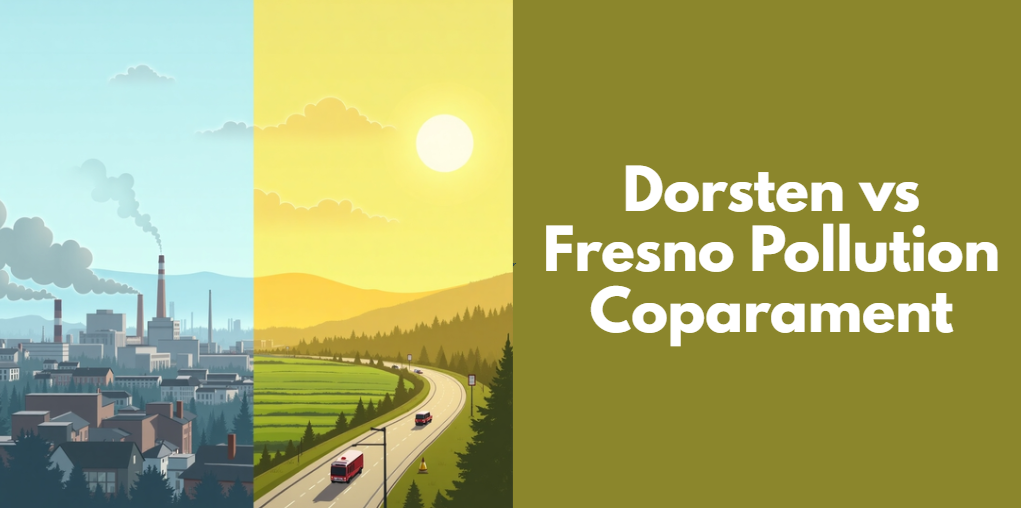Dorsten vs Fresno Pollution Coparament: An In-Depth Environmental Comparison
When discussing urban pollution, it’s common to focus on large metropolises. However, medium-sized cities like Dorsten, Germany, and Fresno, California, offer compelling case studies. The term “dorsten vs fresno pollution coparament” captures a growing interest in comparing environmental challenges between different regions across the globe.
This content aims to explore the pollution landscapes of both cities—covering sources, environmental policies, health implications, and prospects for improvement.
Geographical and Climatic Context
Dorsten is a small industrial city in North Rhine-Westphalia, Germany. Located on the Lippe River, it is influenced by temperate oceanic weather patterns, with moderate rainfall and relatively cool summers. The flat terrain allows for limited air dispersion, which can trap pollutants close to the surface, especially during colder months.
On the other hand, Fresno sits in California’s Central Valley—a region known for its hot summers and cool, foggy winters. The surrounding Sierra Nevada and Coastal Ranges create a “pollution bowl” effect, which traps smog and fine particulate matter, particularly during summer and wildfire season. These geographical differences significantly influence the type and intensity of pollution in each city.
Primary Sources of Pollution
Understanding the source of pollutants helps us identify where mitigation efforts should be focused.
Dorsten:
- Industrial Emissions: Steelworks, refineries, and chemical plants have long operated in the region.
- Traffic Pollution: Dense highway networks and increasing vehicle usage contribute heavily to NOx and particulate matter.
- Domestic Heating: Especially in winter, the use of wood-burning stoves contributes to elevated PM2.5 levels.
Fresno:
- Agricultural Runoff: Pesticides and fertilizers used in farming fields flow into water bodies and affect soil quality.
- Vehicle Emissions: Like many Californian cities, Fresno has a high car ownership rate, leading to considerable CO2 and NO2 emissions.
- Wildfires: Seasonal fires cause severe spikes in air pollutants, especially PM2.5 and ash content.
Air Quality Indicators
Air quality is typically measured using indices such as PM2.5, PM10, nitrogen dioxide (NO2), ozone (O3), and sulfur dioxide (SO2). According to recent data:
| City | PM2.5 (µg/m³) | AQI Rating | Ozone (ppb) | Seasonal Variation |
|---|---|---|---|---|
| Dorsten | 14.6 | Moderate | 29 | High in Winter |
| Fresno | 4.6 | Good | 45 | High in Summer |
Fresno outperforms Dorsten in overall air quality, particularly in PM2.5 concentrations. However, ozone levels in Fresno tend to spike in summer due to high temperatures and vehicle emissions. Dorsten sees worse pollution during winter, largely due to heating sources and industrial output.
Water Pollution Factors
Water quality is equally vital but often overlooked in pollution comparisons.
In Dorsten, water pollution primarily comes from industrial discharge into the Lippe River. Wastewater treatment plants are operational, but trace contaminants from pharmaceuticals and industrial chemicals remain a concern.
Fresno, in contrast, battles agricultural runoff, which introduces nitrates, pesticides, and heavy metals into both surface and groundwater. The water table is especially vulnerable, making Fresno’s water pollution problem more widespread and longer-lasting.
Regulatory Frameworks and Policies
Germany and the United States have different regulatory structures, affecting how pollution is managed.
In Dorsten, environmental policies fall under EU directives. The European Environment Agency (EEA) enforces standards for air and water quality, while local German municipalities like Dorsten have adopted the Bundes-Immissionsschutzgesetz (Federal Immission Control Act) to regulate industrial emissions and traffic pollution.
Fresno operates under the U.S. Environmental Protection Agency (EPA) regulations and California-specific bodies like the California Air Resources Board (CARB). The San Joaquin Valley Air Pollution Control District is particularly active in regulating Fresno’s air quality through emission caps, monitoring, and community outreach.
Monitoring and Data Collection
Monitoring efforts are critical for transparency and accountability. Both cities have established real-time pollution monitoring stations.
Dorsten uses EU-wide tools like the Copernicus Atmosphere Monitoring Service and regional environmental sensors. Citizens can access daily reports via mobile apps and public dashboards.
Fresno utilizes EPA-supported AirNow stations and satellite data. Additionally, universities and nonprofits have launched community-based air sensors that contribute to hyperlocal pollution data.
Health Impacts
Pollution directly impacts public health, with children, the elderly, and those with pre-existing conditions being the most vulnerable.
In Dorsten, the main health issues include respiratory disorders such as asthma and bronchitis, particularly in colder months when PM2.5 levels peak.
Fresno, unfortunately, is frequently ranked among the worst U.S. cities for asthma. Long-term exposure to ozone and smoke particles contributes to increased hospitalizations and a higher prevalence of cardiovascular disease.
Economic Implications
The financial cost of pollution is immense but often underestimated.
- Dorsten: Economic productivity is affected by sick leave and reduced work efficiency due to respiratory conditions. Moreover, investments in pollution control technologies place an economic burden on small businesses.
- Fresno: Healthcare costs due to pollution-related illnesses run into millions of dollars annually. In agriculture, reduced crop yields and water contamination directly affect the local economy.
Community Engagement and Public Participation
Public awareness and participation are key to pollution management.
Dorsten has local programs that engage students and neighborhoods in sustainability projects. Recycling drives, bike-to-work campaigns, and industrial transparency initiatives have helped educate the public.
Fresno hosts air quality workshops and has introduced community air monitoring initiatives. Local advocacy groups often push for stronger environmental justice measures, especially for marginalized communities disproportionately affected by pollution.
Challenges and Opportunities
Both cities face significant challenges:
- Urban growth and increasing vehicle ownership
- Industrial expansion
- Climate change exacerbating seasonal pollution extremes
Opportunities include adopting electric transport, implementing green roofs, and investing in renewable energy. Both cities are exploring AI-based monitoring and predictive models to manage pollution proactively.
Case Studies
- Dorsten: The “Green Corridor” initiative has reduced emissions in heavily trafficked areas by introducing tree buffers and noise barriers.
- Fresno: The Sustainable Groundwater Management Act (SGMA) is an innovative attempt to regulate water use and prevent aquifer depletion.
Comparative Analysis
The “dorsten vs fresno pollution coparament” reveals critical insights:
| Parameter | Dorsten | Fresno |
|---|---|---|
| Primary Pollutant | PM2.5 from industry & heating | PM2.5 & Ozone from cars & wildfires |
| Better Air Quality | ❌ | ✅ |
| Water Quality Issues | Industrial discharge | Agricultural runoff |
| Stronger Regulations | EU + German Federal Laws | EPA + CARB |
While both cities face significant environmental hurdles, their responses are shaped by geography, economy, and governance. Fresno generally has better air quality due to active wildfire mitigation and public policies, while Dorsten benefits from stringent EU regulations.
Future Outlook
Dorsten is investing in hydrogen fuel projects and electric public transport to cut emissions. Fresno is focusing on sustainable agriculture and wildfire resilience. Climate change, however, remains a shared challenge, requiring international collaboration and technological innovation.
Conclusion
In this comprehensive “dorsten vs fresno pollution coparament,” we see that while both cities face unique pollution problems, their solutions reflect local realities. Dorsten is industrial and compact, battling winter pollution.
Fresno is agricultural and expansive, facing summer ozone spikes. Both can learn from each other—be it Fresno’s wildfire readiness or Dorsten’s policy structure. The future of cleaner air and water lies in shared innovation and community action.
Recommended Articles
Discover SWA 12626 XE Burwood Melbourne Australia – Property Guide, Lifestyle & Investment Insight
Aaron Gaun & InvestorLift: The Visionary Powering Real Estate’s Digital Revolution
The Truth Behind the Deep Purple Farewell Tour Hoax: A Deep Dive into Rock’s Most Misleading Goodbye



